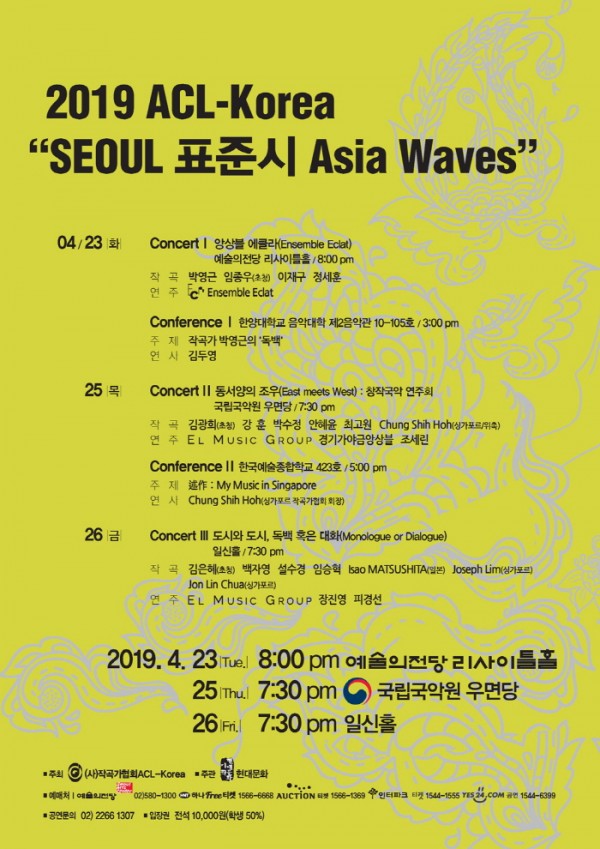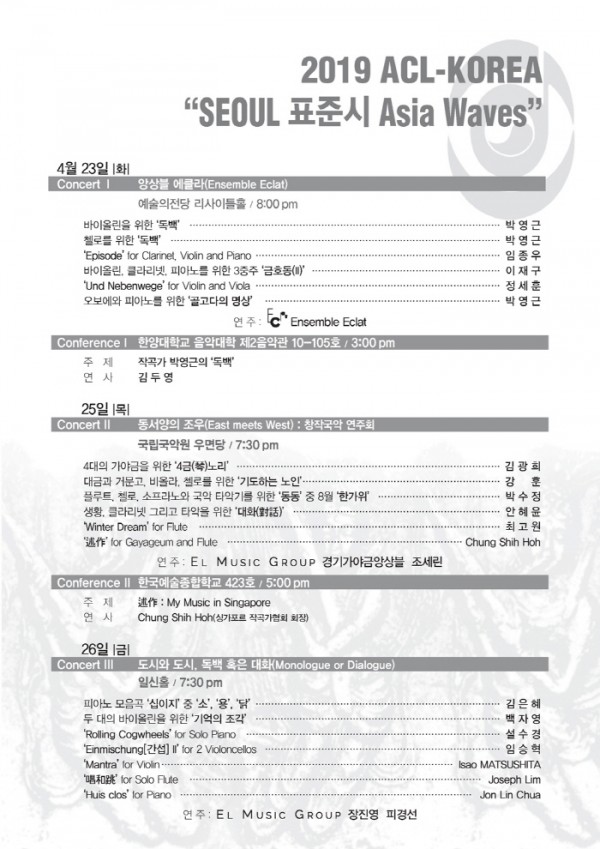Home>공연안내>월간일정
- ACL-Korea 국제음악제 콘서트Ⅲ
- 공연일시
- 2019년 04월 26일 금요일 19:30
- 티켓가격
- 전석 10,000원 (학생50%)
- 공연문의
- 현대문화 02-2266-1307
공연 소개
2019 ACL-Korea
국제음악제 2019
“SEOUL 表俊時(표준시) Asia Waves”
■주최 (사)작곡가협회ACL-Korea ■주관 현대문화
■후원 문화체육관광부, 서울특별시, 서울문화재단
■예매처 예술의전당 인터파크티켓 옥션티켓 예스24공연 하나티켓
■공연문의 02) 2266 1307 ■입장권 전석 10,000원(학생 50%)
2019. 4. 26 |Fri.| 7:30 pm 일신홀
Concert III 일신홀 / 7:30 pm
피아노 모음곡 ‘십이지’ 중 ‘소’, ‘용’, ‘닭’ / 김 은 혜
두 대의 바이올린을 위한 ‘기억의 조각’ / 백 자 영
‘Rolling Cogwheels’ for Solo Piano / 설 수 경
‘Einmischung[간섭] II’ for 2 Violoncellos / 임 승 혁
‘Mantra’ for Violin / Isao MATSUSHITA
‘唱和跳’ for Solo Flute / Joseph Lim
‘Huis clos’ for Piano / Jon Lin Chua
연 주 : EL MUSIC GROUP
[작곡가 / 작품소개]
MATSUSHITA Isao (1951-2018)
작곡가 이사오 마쓰시다는 도쿄 예술대학교에서 학부와 대학원 과정을 졸업하였다.
마쓰시다는 1982년도 오스트리아 그라츠 ISCM과 1988년 홍콩 ISCM, 1993 멕시코 ISCM, 1985년 베를린 호리존테 페스티발, 1985년 코펜하겐 유러피안 뮤직 데이즈, 1986년 베를린 인벤션 페스티발 같은 여러 음악 축제에 참가하였다. 그의 작품 “TOKI-NO-ITO 1 (Threads of Time) for String Quartet” 은 1985년 독일 Moenchengladbach International Composition Competition에서 1위를 수상하였다. 1986년, 마쓰시다는 “TOKI-NO-ITO 2 (Threads of Time) for Piano and Orchestra.” 작품으로 제 7회 Irino Prize에 수상하였다. 그의 오페라 “Shinano-no-Kuni, Zenkoji-Story”는 1998년 나가노 동계올림픽 게임에서 초연되었다. 1999년 “Fujito” for Noh and Strings Quartet”은 도쿄에서 초연되었으며, 같은 해 일본문화관광부 지원 하에 아시안 아트 페스티발 콘서트를 기획하였다. 그는 UC Berkeley, Hamilton, Illinois at Urbana Champaign, Seoul, Central Conservator Beijing 같은 대학교에서 교수로 재직하였다. 그는 도쿄 예술대학의 총장, 일본 작곡가 협회의 회장을 역임했다. 그리고 Camerata Nagano and Bunkyo-Civic Orchestra의 총감독직을 수행했다.
MATSUSHITA Isao obtained both his undergraduate and graduate degrees at Tokyo National University of Fine Arts and Music. Matsushita has participated in several music festivals, such as the “World Music Days of International Society for Contemporary Music (ISCM) Festival in Graz ‘82, in Hong Kong 1988, in Mexico 1993”, “Horizonte Festival Berlin ‘85”, “European Music Days Copenhagen ‘85”, “Invention Festival Berlin ‘86” and so on.
His composition, “TOKI-NO-ITO 1 (Threads of Time) for String Quartet” took first prize in the Moenchengladbach International Composition Competition in West Germany in 1985. In 1986, Matsushita gained the seventh annual Irino Prize with “TOKI-NO-ITO 2 (Threads of Time) for Piano and Orchestra.” His Opera “Shinano-no-Kuni, Zenkoji-Story” was premiered as cultural Program of Winter Olympic Game 1998 in Nagano.In 1999 “Fujito” for Noh and Strings Quartet was premiered inTokyoOn the same year he produced the concerts of “Asian Arts Festival” presented by the Agency for Cultural Affairs of Japan. He had lecture at the several University, such as UC Berkeley, Hamilton,Illinois at Urbana Champaign, Seoul, Central Conservator Beijing and so on.
He is vice president of Tokyo University of the Arts, Professor of Performing Arts Center and President of the Japan federation of Composers (JFC).
‘MANTRA’ for Violin solo (2001)
산다는 것은 계속해서 고통으로부터 이겨내는 것을 경험하는 것이다. 지구상에 주어진 모든 삶은 이 정해져 있는 고통으로부터 도망치려고 괴로워한다. 우리는 신에게 이러한 고통으로부터 도망치고 싶다고 기도하고 있지 않은가? 기도하고, 희망하고, 또 사랑하고...
나는 이 작품을 쓸 당시에 위의 생각들이 내 작품 안으로 깊숙이 파고들기를 희망하며 작곡했다. 만트라는 산스크리트어로 수트라라는 뜻이다. 이번 작품에서 “아칼라” 앞에 찬양 곡에 사용되는 8분음 리듬의 만트라, 8+6+7박자 리듬을 사용하였다. 서론-본론-빠른 피날레의 형식으로 진행되며, 점차 정제되어지며, 그리하여 기도하는 사람이 된다. 음악적 변형을 통하여 108번 반복되어지며, 이것은 우리가 기도하며 세는 백팔번뇌의 숫자와 동일하다.
To live is to experience a continuous succession of sufferings. Those given life on Earth struggle to escape from the sufferings set upon them. Do we offer a prayer for an escape, however brief, from these sufferings?” To pray, to wish and to love…I would like to weave these thoughts into my piece at this moment in time. Mantra means sutra in Sanskrit. In this work, I used the 8 + 6 + 7 - eights rhythm of a mantra chanted in front of “Acala”. Following the form . Introduction-Flowing . Rapid finale, it is refined and becomes a prayer. Through metamorphosis it repeats 108 times, the same as the number of desires we are said to have.
Jon Lin Chua
존 린 취아는 Oliver Schneller, Ricardo ZohnMuldoon, Robert Morris, David Liptak과 Robert Casteels를 사사했고, 작곡가 Moritz Eggert와 Louis Karchin이 가르치는 마스터 클래스에 참여하였다. 이스트만에서 Tony Caramia를 사사하여 페다고지를 공부하였고 피아노과 교수인 Vincent Lenti에게 지도 받았다. 피아니스트로서 뿐만 아니라 얼후 연주자로서도 중국 중앙음악원에서 연주학위를 받았다. 또한, 존 린은 난인 음악이나 다양한 장르의 전통 중국 오페라와 같은 음악에도 많은 노력을 기울여서 현대 북인디안 뮤직 트리오나 Flame of the Forest 같은 연주자들과 협업하여 공연하였다.
존 린은 ‘A Collapse of Musical Categories?’ 라는 제목으로 중국 전통음악원을 포함하여 중국 민족음악에 대한 논문을 기고하기를 요청 받았다. 그녀의 최근 연구는 헬무트 라헨만의 음악과 같은 음색에 초점을 맞춘 작업을 분석적으로 접근해 나가고 있다. 또한 존 린은 싱가포르 국립대학교에서 철학과 학사 과정 졸업을 목표하고 있다.
Her teachers in composition include composers Oliver Schneller, Ricardo Zohn Muldoon, Robert Morris, David Liptak, and Robert Casteels, and she has participated in composition masterclasses with Moritz Eggert and Louis Karchin. In Eastman, she also studied piano performance under the tutelage of classical/jazz pianist and pedagogue Tony Caramia, and has also received instruction from Vincent Lenti, piano professor at the Eastman School of Music. Apart from being a pianist, she is also an erhu player, and has obtained a performance diploma from the Central Conservatory of Music of China. In addition, Jon Lin has also taken the effort to venture into alternative styles of music, including traditional Nanyin music, various subgenres of traditional Chinese opera, and has collaborated with Flame of the Forest, a contemporary Northern Indian music trio.
Jon Lin was also invited to present her paper A Collapse of Musical Categories? : A Closer Look at Ethnic Chinese Music within the Chinese Conservatory Tradition Today at the Composition in Asia International Symposium and Festival held in the University of Florida(2015). Her recent research interests include analytical approaches to timbre based works, as well as the music of Helmut Lachenmann. her degree in music, Jon Lin obtained a B.A. (Hons) in philosophy from the National University of Singapore.
‘Huis clos’ for Piano
피아노 독주를 위한 ‘Huis clos’는 프랑스의 실존주의 철학자인 쟌-플 사트레(Jean Paul Sartre)가 쓴 동명의 연극으로부터 영감을 얻었으며 영어로는 ‘닫힌 방 (No Exit)’으로 번역되기도 한다.
이 연극은 앤틱가구로 꾸며진 방에서 오직 네 명의 등장인물이 연기를 이어 나간다. 연극이 전개되면서 청중들은 이 무대가 세 명의 주인공이 죽은 후 도착한 지옥을 묘사하고 있다는 것을 깨닫게 된다.
그들은 각자 비밀리에 그들을 기다리는 극심한 고문에 대해 고심하며 궁극적으로 상대방의 시선으로 만들어진 지옥에서 괴롭히는 자이자 희생자로 육체적인 고통보다 더한 고문을 당하고 있다는 것을 알게 된다. 연극과 마찬가지로, 음악에서 대부분의 긴장감과 극적요소는 이따금 나타나는 명백한 폭발과 함께 표면 깊숙이 깔려 있다. 때때로 방해하는 에너지의 깜빡거림에도 불구하고 이 작품은 음악적 짜임새가 되는 반복적인 형태로 시작된다. 음악적 표면에는 상당한 움직임이 있음에도 불구하고 이것은 점차적으로 무너져 작품의 전반적인 궤도는 정적이다. 이것은 극중 무거운 철학적 주제를 가볍게 덮어버리는 대부분의 대화에서 나타나는 냉담하고 사소한 것들을 반영한다.
Huis clos is piece for solo piano, inspired by French existentialist philosopher JeanPaul Sartre’s play of the same title, often translated to English as “No Exit.” The entire play takes place in a room with antiquated furnishings, and features only four characters. As the play unfolds, the audience realizes that it is a depiction of hell, and that three of the characters have died and been sent to this room. As they each secretly ponder upon the sort of severe torture that awaits them, each ultimately comes to realize that he/she simultaneously serves as tormentor and victim to one another, in a hell sculpted simply by the gaze of the Other, a torture worse than all physical brutality. Like the play, most of the tension and drama in the music lies deep beneath the surface, with the occasional overt outburst. The piece opens with a repeated figure that comes to dominate the musical texture, despite the flickers of energy that interrupt from time to time. Although there is a fair amount of activity on the musical surface, it gradually breaks down, and the overall trajectory of the piece is static, reflecting the stifling vapidity and triviality found in most of the play’s dialogue that thinly veil the weighty philosophical themes within.
Joseph Lim (Lim Soon Keong Joseph)
조세프 림(1994년 출생)은 작곡가, 교육자이자 색소폰 연주자이며 피아니스트이다. the English Young Artist Sinfornia, CHROMA, Hermes Experiment, Lontano, Singapore Chinese Orchestra, Audioimage Wind Ensemble and ADDO Chamber Orchestra에서 연주하였다. 조세프는 싱가포르 작곡가와 작가 협회(COMPASS)의 회원이며, 동시에 싱가포르 작곡가 협회 회원이다. 그는 전통음악 작곡에 많은 영향을 받아 작곡








